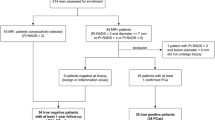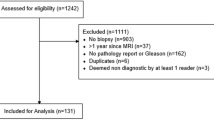Abstract
Objectives
To evaluate if computer-aided diagnosis (CAD) prior to prostate multi-parametric MRI (mpMRI) can improve sensitivity and agreement between radiologists.
Methods
Nine radiologists (three each high, intermediate, low experience) from eight institutions participated. A total of 163 patients with 3-T mpMRI from 4/2012 to 6/2015 were included: 110 cancer patients with prostatectomy after mpMRI, 53 patients with no lesions on mpMRI and negative TRUS-guided biopsy. Readers were blinded to all outcomes and detected lesions per PI-RADSv2 on mpMRI. After 5 weeks, readers re-evaluated patients using CAD to detect lesions. Prostatectomy specimens registered to MRI were ground truth with index lesions defined on pathology. Sensitivity, specificity and agreement were calculated per patient, lesion level and zone—peripheral (PZ) and transition (TZ).
Results
Index lesion sensitivity was 78.2% for mpMRI alone and 86.3% for CAD-assisted mpMRI (p = 0.013). Sensitivity was comparable for TZ lesions (78.7% vs 78.1%; p = 0.929); CAD improved PZ lesion sensitivity (84% vs 94%; p = 0.003). Improved sensitivity came from lesions scored PI-RADS < 3 as index lesion sensitivity was comparable at PI-RADS ≥ 3 (77.6% vs 78.1%; p = 0.859). Per patient specificity was 57.1% for CAD and 70.4% for mpMRI (p = 0.003). CAD improved agreement between all readers (56.9% vs 71.8%; p < 0.001).
Conclusions
CAD-assisted mpMRI improved sensitivity and agreement, but decreased specificity, between radiologists of varying experience.
Key Points
• Computer-aided diagnosis (CAD) assists clinicians in detecting prostate cancer on MRI.
• CAD assistance improves agreement between radiologists in detecting prostate cancer lesions.
• However, this CAD system induces more false positives, particularly for less-experienced clinicians and in the transition zone.
• CAD assists radiologists in detecting cancer missed on MRI, suggesting a path for improved diagnostic confidence.






Similar content being viewed by others
Abbreviations
- AUC:
-
area under the curve
- CAD:
-
computer-aided diagnosis
- DCE:
-
dynamic contrast-enhanced imaging
- DWI:
-
diffusion-weighted imaging
- GS:
-
Gleason score
- ISA:
-
index of specific agreement
- mpMRI:
-
multi-parametric MRI
- PI-RADS:
-
Prostate Imaging Reporting and Data System
- PSA:
-
prostate-specific antigen
- PZ:
-
peripheral zone
- T2W:
-
T2-weighted
- TRUS:
-
transrectal ultrasound
- TZ:
-
transition zone
References
Society AC (2016) Cancer facts & figures 2016. American Cancer Society, Atlanta
Graif T, Loeb S, Roehl KA et al (2007) Under diagnosis and over diagnosis of prostate cancer. J Urol 178:88–92
Draisma G, Etzioni R, Tsodikov A et al (2009) Lead time and overdiagnosis in prostate-specific antigen screening: importance of methods and context. J Natl Cancer Inst 101:374–383
Brown AM, Elbuluk O, Mertan F et al (2015) Recent advances in image-guided targeted prostate biopsy. Abdom Imaging 40:1788–1799
Meng X, Rosenkrantz AB, Mendhiratta N et al (2016) Relationship between prebiopsy multiparametric magnetic resonance imaging (MRI), biopsy indication, and MRI-ultrasound fusion-targeted prostate biopsy outcomes. Eur Urol 69:512–517
Siddiqui MM, Rais-Bahrami S, Turkbey B et al (2015) Comparison of MR/ultrasound fusion-guided biopsy with ultrasound-guided biopsy for the diagnosis of prostate cancer. Jama 313:390–397
Schoots IG, Roobol MJ, Nieboer D, Bangma CH, Steyerberg EW, Hunink MG (2015) Magnetic resonance imaging-targeted biopsy may enhance the diagnostic accuracy of significant prostate cancer detection compared to standard transrectal ultrasound-guided biopsy: a systematic review and meta-analysis. Eur Urol 68:438–450
Borkowetz A, Platzek I, Toma M et al (2016) Direct comparison of multiparametric MRI and final histopathology in patients with proven prostate cancer in MRI/ultrasound-fusion biopsy. BJU Int. https://doi.org/10.1111/bju.13461
Rosenkrantz AB, Deng FM, Kim S et al (2012) Prostate cancer: multiparametric MRI for index lesion localization–a multiple-reader study. AJR Am J Roentgenol 199:830–837
Borofsky S, George AK, Gaur S et al (2017) What are we missing? False-negative cancers at multiparametric MR imaging of the prostate. Radiology. https://doi.org/10.1148/radiol.2017152877:152877
Garcia-Reyes K, Passoni NM, Palmeri ML et al (2015) Detection of prostate cancer with multiparametric MRI (mpMRI): effect of dedicated reader education on accuracy and confidence of index and anterior cancer diagnosis. Abdom Imaging 40:134–142
Gaziev G, Wadhwa K, Barrett T et al (2016) Defining the learning curve for multiparametric magnetic resonance imaging (MRI) of the prostate using MRI-transrectal ultrasonography (TRUS) fusion-guided transperineal prostate biopsies as a validation tool. BJU Int 117:80–86
Wang S, Burtt K, Turkbey B, Choyke P, Summers RM (2014) Computer aided-diagnosis of prostate cancer on multiparametric MRI: a technical review of current research. Biomed Res Int 2014:789561
Liu L, Tian Z, Zhang Z, Fei B (2016) Computer-aided detection of prostate cancer with MRI: technology and applications. Acad Radiol. https://doi.org/10.1016/j.acra.2016.03.010
Litjens GJ, Elliott R, Shih NN et al (2015) Computer-extracted features can distinguish noncancerous confounding disease from prostatic adenocarcinoma at multiparametric MR imaging. Radiology. https://doi.org/10.1148/radiol.2015142856:142856
Litjens GJ, Barentsz JO, Karssemeijer N, Huisman HJ (2015) Clinical evaluation of a computer-aided diagnosis system for determining cancer aggressiveness in prostate MRI. Eur Radiol 25:3187–3199
Peng Y, Jiang Y, Yang C et al (2013) Quantitative analysis of multiparametric prostate MR images: differentiation between prostate cancer and normal tissue and correlation with Gleason score–a computer-aided diagnosis development study. Radiology 267:787–796
Tiwari P, Kurhanewicz J, Madabhushi A (2013) Multi-kernel graph embedding for detection, Gleason grading of prostate cancer via MRI/MRS. Med Image Anal 17:219–235
Niaf E, Lartizien C, Bratan F et al (2014) Prostate focal peripheral zone lesions: characterization at multiparametric MR imaging–influence of a computer-aided diagnosis system. Radiology 271:761–769
Niaf E, Rouviere O, Mege-Lechevallier F, Bratan F, Lartizien C (2012) Computer-aided diagnosis of prostate cancer in the peripheral zone using multiparametric MRI. Phys Med Biol 57:3833–3851
Hambrock T, Vos PC, Hulsbergen-van de Kaa CA, Barentsz JO, Huisman HJ (2013) Prostate cancer: computer-aided diagnosis with multiparametric 3-T MR imaging–effect on observer performance. Radiology 266:521–530
Berbaum KS, Krupinski EA, Schartz KM et al (2015) Satisfaction of search in chest radiography 2015. Acad Radiol 22:1457–1465
Lay N, Tsehay Y, Greer MD et al (2017) Detection of prostate cancer in multiparametric MRI using random forest with instance weighting. J Med Imaging (Bellingham) 4:024506
Medixant (2015) RadiAnt DICOM Viewer, 2.2.9.10728. http://www.radiantviewer.com/
Radiology ACo (2015) MR Prostate Imaging Reporting and Data System version 2.0.
Shah V, Pohida T, Turkbey B et al (2009) A method for correlating in vivo prostate magnetic resonance imaging and histopathology using individualized magnetic resonance-based molds. Rev Sci Instrum 80:104301
Kim YW, Mansfield LT (2014) Fool me twice: delayed diagnoses in radiology with emphasis on perpetuated errors. AJR Am J Roentgenol 202:465–470
Muller BG, Shih JH, Sankineni S et al (2015) Prostate cancer: interobserver agreement and accuracy with the revised Prostate Imaging Reporting and Data System at multiparametric MR imaging. Radiology. https://doi.org/10.1148/radiol.2015142818:142818
Rosenkrantz AB, Ginocchio LA, Cornfeld D et al (2016) Interobserver reproducibility of the PI-RADS Version 2 Lexicon: a multicenter study of six experienced prostate radiologists. Radiology. https://doi.org/10.1148/radiol.2016152542:152542
Rosenkrantz AB, Oto A, Turkbey B, Westphalen AC (2016) Prostate Imaging Reporting and Data System (PI-RADS), Version 2: a critical look. AJR Am J Roentgenol 206:1179–1183
Hansen NL, Koo BC, Gallagher FA et al (2016) Comparison of initial and tertiary centre second opinion reads of multiparametric magnetic resonance imaging of the prostate prior to repeat biopsy. Eur Radiol. https://doi.org/10.1007/s00330-016-4635-5
Funding
The study has received funding by the Intramural Research Program of the NIH, National Cancer Institute, Center for Cancer Research (Grant ZIA BC 010655).
Author information
Authors and Affiliations
Corresponding author
Ethics declarations
Guarantor
The scientific guarantor of this publication is Baris Turkbey, MD.
Conflict of interest
The authors of this manuscript declare relationships with the following companies: Bradford Wood, Philips and InVivo; Ronald Summers, Ping An and iCAD.
Statistics and biometry
One of the authors, Dr. Joanna Shih, has significant statistical expertise.
Ethical approval
Institutional review board approval was obtained.
Informed consent
Written informed consent was obtained from all patients in this study.
Study subjects or cohorts overlap
Some study subjects or cohorts have been previously reported in Greer MD, Shih JH, Lay N, et al. Validation of the dominant sequence paradigm and role of dynamic contrast-enhanced imaging in PI-RADS Version 2. Radiology. 2017;285:859–869.
Methodology
• retrospective
• diagnostic study
• multicentre study
Electronic supplementary material
ESM 1
(DOCX 18 kb)
Rights and permissions
About this article
Cite this article
Greer, M.D., Lay, N., Shih, J.H. et al. Computer-aided diagnosis prior to conventional interpretation of prostate mpMRI: an international multi-reader study. Eur Radiol 28, 4407–4417 (2018). https://doi.org/10.1007/s00330-018-5374-6
Received:
Revised:
Accepted:
Published:
Issue Date:
DOI: https://doi.org/10.1007/s00330-018-5374-6




